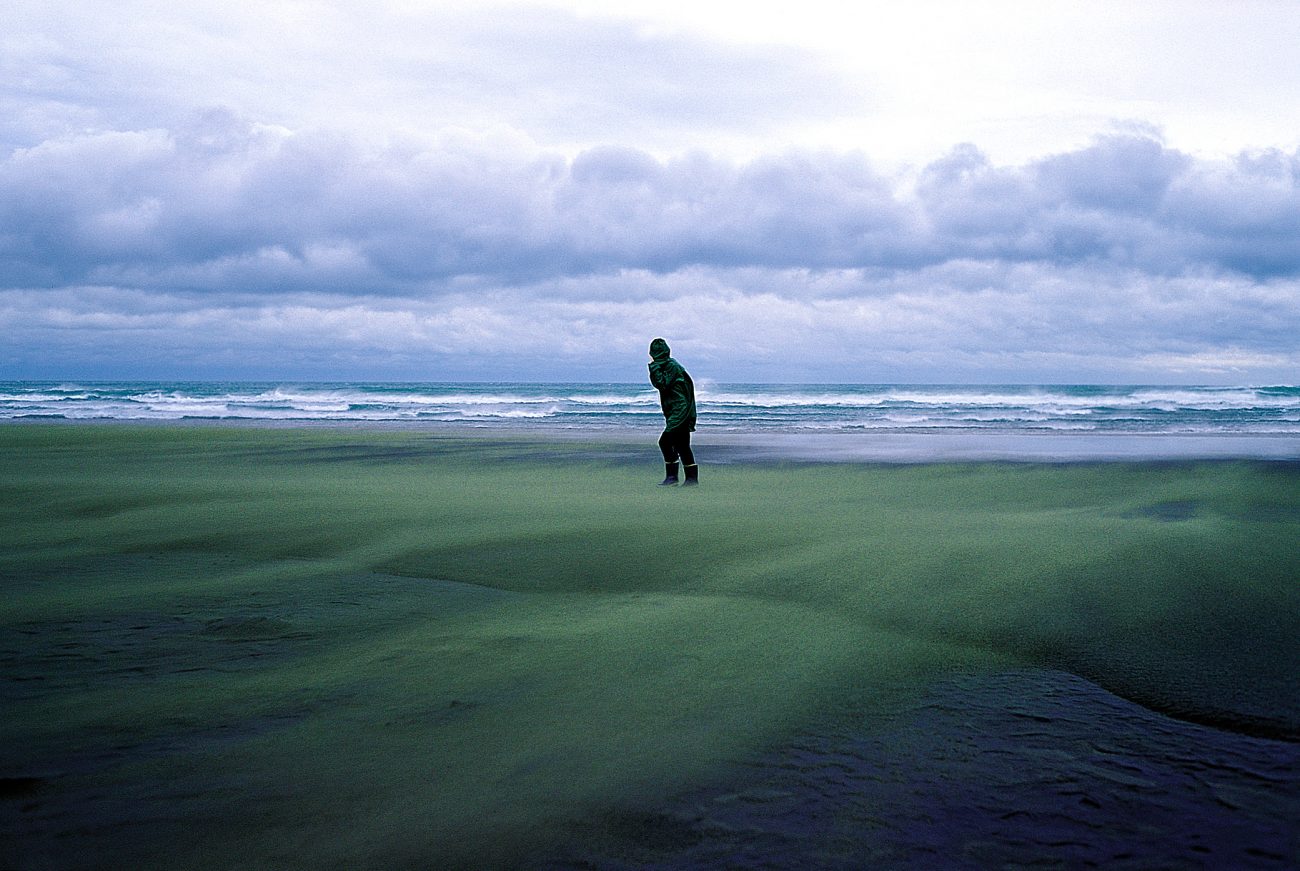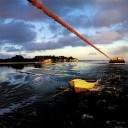
Dunes: the waterless sea
A scything ridge of sand—very emblem of desert lands—runs into the great wilderness that is Kokota, the bull-nosed southern head of Parengarenga Harbour. The Far North is a region built on sand, much of it now cloaked with pine and pasture, but in some parts still exposed as shifting dunes: primal landforms as alluring as they are austere.





At the northern end of Twilight Beach is a place between two massive dunes where you can look for miles and not see any vestige of human activity except the rotating beam of Cape Reinga lighthouse. You can find Saharan solitude in a place like this, created and defined by sand.
During the day the heat is intense and the reflection blinding. Whether I am suffering delirium caused by dehydration or whether I am tuned into the recondite meaning of the area, I cannot say. But for all the excitement evoked by an outstanding landscape, I can’t shake off a feeling of sadness.
I watch the sun set in the sea behind Cape Maria van Diemen. Although it is the height of summer, a cold southerly whistles up the coast. I sit, playing with a bleached shell, thinking that if my soul should pass this way at the time of my departure I would count it a privilege.
Shifting my focus from the profound to the mundane, I notice that I am surrounded by dozens of flax-snail shells, white and ancient like bones in a desert. Their cone-shaped spires are packed with sand, the grains cemented together by time. Sand and shell have bonded, perishable animal flesh displaced by an imperishable mineral conglomerate.
What has happened here? It looks like a centuries-old Maori rubbish dump that has been raked over and scattered. Do the snail shells represent the indigestible remains of a big feast, or are they remnants of a pre-Blitzem effort to control garden pests? More likely, sand simply inundated the forest that once spread its boughs here.
Sand is a force to be reckoned with, especially if you are a moist, slow-moving mollusc. Its legion of foot soldiers (approximately five million grains per kiddy-sized bucketful) make up a relentless territorial army. They crawl out of the sea, dry off at the beach and then hitch a ride with the next gust, to disperse over the land like paratroopers.

The history of these waves of granular invasion can be found in sedimentary rocks. Mike Eagle, a palaeontologist for the Auckland Museum, is one who reads the sand sagas, and the wider library of geological transformation, too. “Time travel,” he calls it, and, like most travellers, he is always looking for new horizons.
“You’ve got to get away from thinking you are looking at rock,” he says, pulling closed the door to his time machine, made in Japan. I notice that the second-gear synchro is kaput as we drive towards the north head of Manukau Harbour. “What you are looking at are time zones such as the Jurassic, the Oligocene or the Pleistocene. Think of them as horizons of time.
“Sand is a very young product of very old rocks. It is part of a recycling process that has been going on for as long as the planet has existed.”
If we could have tagged a grain of sand, say, 150 million years ago, in the Jurassic era, and followed it through the eons, chances are it would have been up in the highest mountains and down in the fiery bowels of the Earth several times.
Rock is continuously being reworked by geological processes—spat out by volcanic eruptions, eroded back to seafloor mud, pressed into sedimentary rock and pushed up in the collision zones of tectonic plates, creating mountains such as the Southern Alps.
Suppose our grain of sand resurfaces via a volcano on the North Island’s central plateau.
Over time, that volcanic rock breaks down into sand and dust. Rain and gravity carry the sand into streams and rivers, reaching the coast at Port Waikato. Once at sea, the sand grains are shifted northward by the ocean’s long-shore drift, being repeatedly eroded and deposited along the west coast beaches. (At Whatipu, sand is being deposited at a rate of 30,000 tonnes per annum; it is also being eroded from nearby Awhitu Peninsula at about the same rate.)
“The heavy ironsands fall out of suspension earlier than the other stuff, which is why you don’t get any black ironsand beaches north of Pouto,” says Eagle. “Some of these black sands have such a high iron content that lightning can fuse it into rods half a metre long.”
The lighter, gold-coloured sands find little rest before being carried further north by the ocean’s coastal current or blown inland perhaps as much as 20 km by the prevailing westerly winds to form the dunelands of today.
At daybreak, the giant ochre camel-humps of the dunes rendezvous with a steel-blue morning sky. Bare feet and sand go together. The sand of the Te Paki dunes is so fine it feels like walking on mountains of flour.
The flat morning light casts soft shadows from the wave patterns in the sand. A sea without water, formed by the wind. Sandstone columns loom above its surface like the smokestacks of sunken liners.
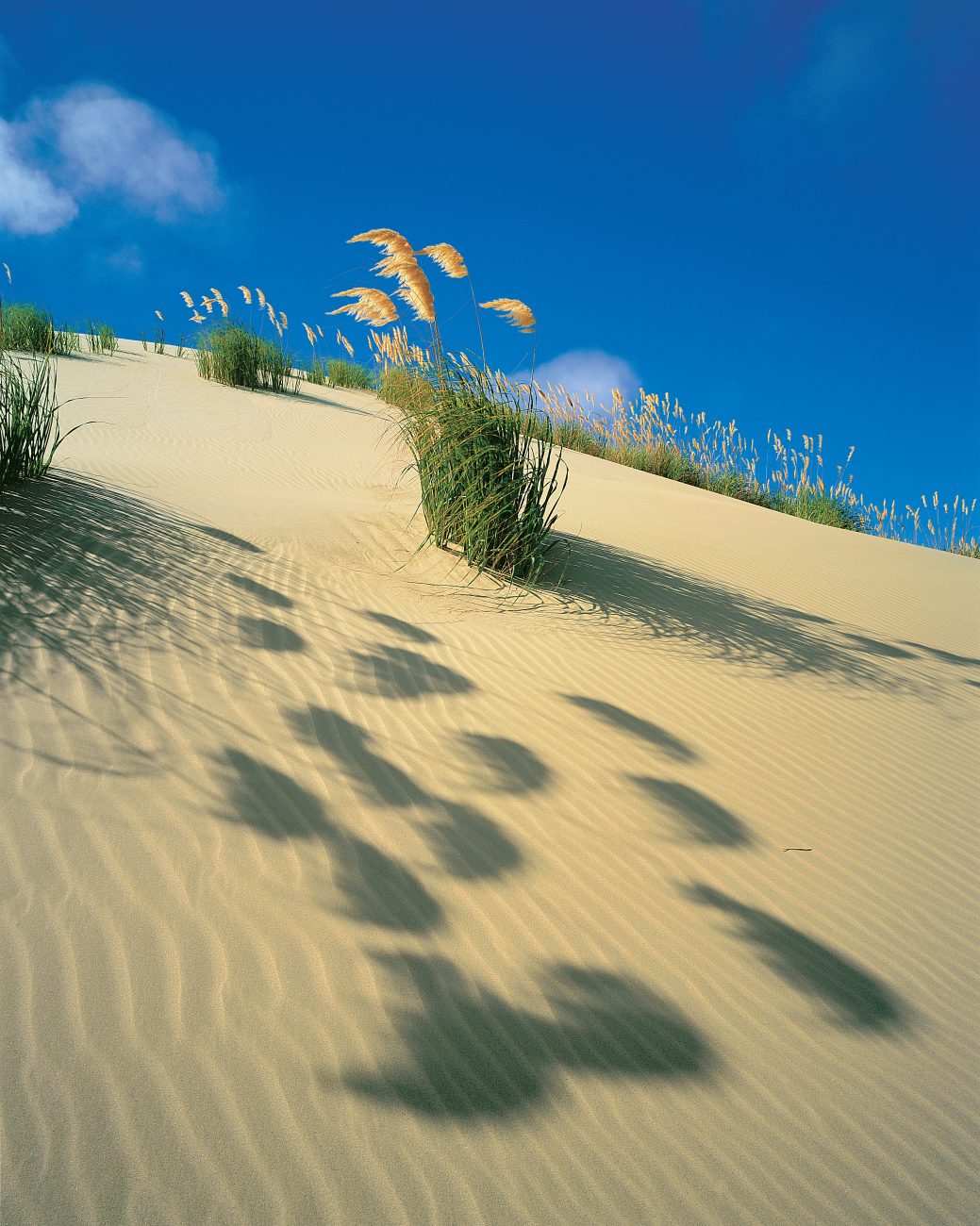
Tufts of toetoe are poised like sailing ships in the distance, and long lines of pingao and spinifex stretch precariously down the face of a sandy cliff. Roped together like the members of a climbing party, they seem intent on conquering the thin horizons of sediment baked by the sun into a fragile filo pastry.
A puff of wind sends a straw-coloured spinifex flowerhead tumbling hurriedly over the sand, important, like some terribly late Christmas-tree decoration.
Its Sputnik-like extremities become caught in a pink teatree. Right next to the low bush is a squadron of wasps. Low-flying, non-radar-detectable wasps. Suddenly, with lightning speed, the fleet swoops to the left, dives the entire 10 cm to the ground and converges on something in a ball of frenzy. The demise of an enemy, I think, but what looks initially like a kill on the wing reveals itself as an orgy and turns me into a voyeur. The queen wasp has just been unceremoniously fertilised by her entire air force.
At direction two o’clock, only a few seconds’ flight away, I can make out symmetrical tracks in the sand. What looks like evidence of tank activity on a miniature battlefield turns out to be the footprints of a beetle. Its trail leads across the dune in a rhythmic staccato and passes the small cruciform imprints left by a pipit. A third set of prints, unmistakably paw prints, joins a couple of metres further on. Did the bird, possibly snacking on a nimble beetle, become an unsuspecting meal itself? Or were all these prints made hours or days apart, preserved by a spell of fine weather? It is like reading the fading headlines of a dune tabloid: “Murder in the Sands!”
[Chapter Break]
The dunes have had to fight some battles of their own in recent times. Housing projects like that on the Omaha sandspit, north of Auckland, backfired. The dunes took exception to being developed, domesticated and marketed as seaside suburbia.
Disregard for the earliest building code known to the orthodox world, which states quite clearly not to build on sand, resulted in house owners at Omaha having to shovel sand out of their back yards, instead of mowing lawns.
Dunes are more than a background nuisance for coastal property developers. They can be fearsome heavyweights, aeolian sumo wrestlers. A dune 30 m high, 100 m wide and 200 m long is a mobile 500,000-tonne giant able to choke, bury and squash everything in its way. In his poem “Sand Dunes,” the American poet Robert Frost writes:
They are the sea made land
To come at the fisher town,
And bug in solid sand
The men she could not drown.
Frost could not have been conned into buying a section at Omaha!
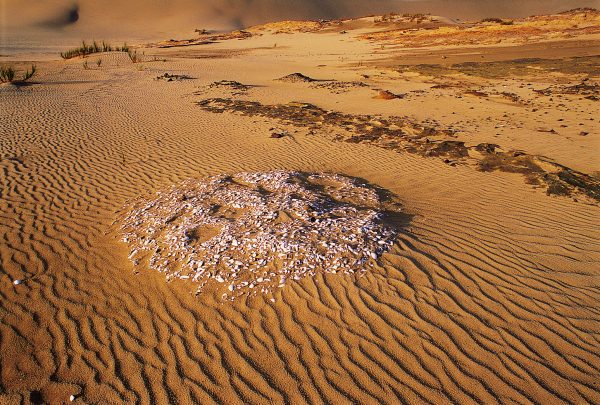
The forestry industry has a more favourable track record when it comes to utilising dunes. Thirty-five years after the movement of the sand giants was successfully arrested by planting a succession of marram grass, lupins and finally pines, the Aupouri Forest behind Ninety Mile Beach today occupies 300 sq km of sand. Large pine forests have been established on most of the dunes in the Northland-Auckland region—north of the Waikato River mouth, around the Kaipara and Hokianga Harbours, and on the east coast behind Great Exhibition Bay and around Te Arai Point.
Although the dunes may have been put to rest under a green quilt for now, it is most likely to be only a nap in geological terms. If you have gambling blood in your veins and want to bet on what will be there in 10,000 years, put your money on the dunes!
In the Te Paki sands, between the beach and the forest, is a twisted old pohutukawa tree, besieged by dunes on all sides. Nearby, sea monsters and ancient Tom Thumb-sized cities subside and resurface like derelict parts of an alien civilisation of my imagination. These bizarre shapes are created in limonite. Iron, leaching from sand and substrate and becoming concentrated in shallow basins and pockets, cements sand together into a labile, often exquisitely delicate pottery. Exposed by the wind, brown and black, it may resemble growths of black tree fungus or extrusions of molten chocolate snap-frozen in the air. Some are as big as a spa pool, and easy winners of any freeform sculpture competition. Smaller pieces, perfectly round and concave, the size of an antique wine cup, occasionally yield amber-like pebbles, as if waiting to be blessed and presented as offerings to the gods of wind, water and time.
Human time in the Northland dunes, according to present knowledge, began around the 12th or 13th century A.D. Eight centuries is a respectable amount of time for a man’s words to endure and still be remembered—and so it is with Tohe’s words.
Tohe, a chief and early ancestor of the Kurahaupo people, was an old man when he announced that he would walk from his pa on Maungapiko, at the northwestern point of Spirits Bay, to the Kaipara, where he wanted to visit his daughter. Some of his tribe begged him not make this journey, as it would be long and treacherous and take him through enemy territory. He replied:
“I can shelter from the wind
But not from the longing for my daughter.
I shall venture as far as Hokianga,
And beyond, all that you shall possess
Is my spirit.”
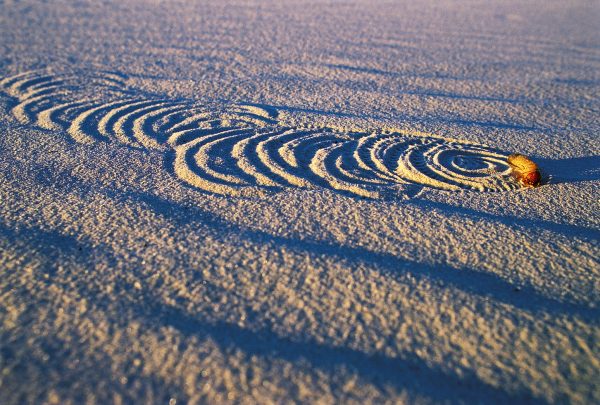
Humankind had only just discovered these islands, and many places and waters lacked names. Tohe bestowed many names as he walked along the west coast from Te Paki to Maunganui Bluff. Most are still in use, such as Te Paki itself, “the place where the weather turned fine,” or Te Wharo Oneroa a Tohe, “the long sands travelled by Tohe” (Ninety Mile Beach).
A couple of centuries after Tohe’s walk, some of his descendants camped in the dunes of Aupouri. They had walked out from the hinterland, following a stream, and were setting up a camp for the summer months to gather and process seafood. Posts were dug into the ground to support a drying rack. Soon the smoke of hangi fires filled the air. Women cured fish, while the men hunted seal, and children ran around wearing necklaces of dried shellfish, like edible jewellery.
“We also found some kereru [native pigeon] bones at their campsite,” says Joanne Minghy, an archaeologist with the Department of Conservation in Whangarei. She believes that around 1400 A.D. kauri forest must have covered land that is now occupied by dunes, hence the remains of a forest bird in the sands.
[Chapter Break]
I am deep in a dune canyon on the north head of the Hokianga Harbour. The sheer sides of sand reach up some 30 m, leaving the sky as nothing but a narrow, blue ribbon above. A small stream spills its milky tea-water over a sandy bed.
As I sit and listen, I notice a rhythm in the flow of the water. With the precision of clockwork, the water pulses every 10 seconds. Intrigued, I walk cautiously up the stream, hoping to find an explanation. The sides of the canyon continuously break off in car-size chunks, like calving glaciers. The only route is the streambed. I feel nervous. The canyon walls are so close, I can almost touch them with my outstretched arms.
Everything is on the move. The ground underfoot is getting softer—too soft. Around the next corner, I step into nowhere and within a second I am up to my knees in sand. Quicksand! Two attempts to free myself only result in being buried deeper. Panic battles with the need for a clear head. I notice a log sticking out from the side of the canyon wall above me, but it is just out of reach. Feverishly, I take off my day pack and extend the shoulder straps to maximum length. Holding on to its top, I cast the pack like a lasso. One of the straps hooks over the log. I carefully extract myself, with a prayer for the log and the manufacturers of the pack.

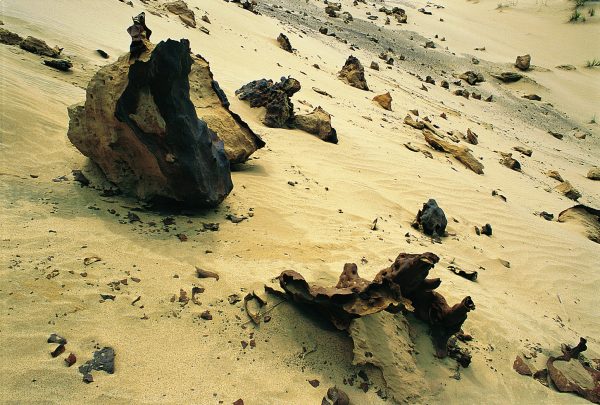
Shortly after my lesson in dune survival, I have one in serendipity. I pick up a hitch-hiker. Following an introduction and the obligatory “where to” and “where from,” Gloria reveals that she is obsessed by sand, describing herself as an arenophile.
“I’m an artist, and I’ve been working on a project counting grains of sand for all the people in America,” she says. “I figured that the whole US population of 250 million would make a pile half a cubic metre in size. To make the numbers tangible, and magnify the individuality of the grains, I am also bottling sand to represent groups of individuals in the world—for example, the number of people who are currently incarcerated in the US, who live in New York City, or who live in Australia.”
“I guess all of us Kiwis would fit into a plastic drink bottle,” I reply.
The conversation stays centred on sand. One grain to look at, 1000 to determine the time lag between a soft- and a hard-boiled egg, 10 million to build a small sand castle. My passenger tells me about a museum in France dedicated solely to sand, where glass sample bottles filled with sand from all over the world make for a most spectacular display.
Later that day I am among magnificent sandstone formations, with fantastic colours and shapes. In hillocks of kneaded dough, layered with strata of varying shades of ochre, water and wind have formed a labyrinth of channels. There are no sharp edges; everything is smooth and rounded with playful bulges and indentations as if designed by the late Friedensreich Hundertwasser to become the nation’s most imaginative skateboarding course.
The free-flowing lines encourage the mind to ponder the surrounding sandscapes, and I recall Mike Eagle’s projection into the future, where our sand grain solidifies with others to become sandstone. In his time machine, he lets the sea level rise 145 m. Large tracts of Northland disappear beneath the oceans. New sediments are deposited on the seafloor. He adds a pinch of plate tectonics and the whole lot either disappears in a fault line, erupts in a gigantic volcanic event or gets pushed up and lifted out of the sea again as the “Kaitaia Alps.” This process could take 100 million years.
At the end of that time our grain of sand is once again embedded in greywacke. As we watch, the rock erodes away and the grain washes into a river and into an ocean that has no name. It is on its way to becoming a dune again, another wave in the waterless sea.







